PeopleProducts123 reconnects labor and products through improved packaging featuring images and stories about the workers who make them. This improved packaging is placed in stores using a technique called shopdropping (the opposite of shoplifting) in which items are clandestinely left in retail environments.
Research
The Anti-Advertising Agency’s Amanda Eicher traveled to Colima, El Salvador meeting people who make products we consume throughout the world. People like Rosa, a teacher whose student numbers drop during harvest times because the children are working in the fields. Yaneth, a student in town, and people who work for (or subcontract to) companies including Coca-Cola and Dell. When in the Unites States, Amanda worked on reaching out to other photographer/researchers who document laborers both in the US and abroad.
-

-
Rosa, school teacher
-
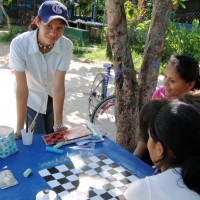
-
Yaneth, student in Colima
-

-
Schoolchildren in Colima
-

-
Indian child working on lightbulbs
-

-
13yo Migrant Photo by U. Roberto Romano
Create
Our idea was to have the image of the person who worked on the product appear on the product itself. The next step was crafting new packaging for the products the laborers from our research work on.
One of the difficulties was establishing direct connections between the labor and the products. The production system is often contracted out and so sophisticated that the employees of a facility often have no idea what they are working on.
The drawings and designs for the packaging were done by Amanda Eicher with Steve Lambert assisting with coloring and providing feedback.
-

-
Colored drawing for Boy Migrant
-
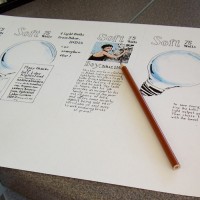
-
Amanda Eicher’s drawings
-
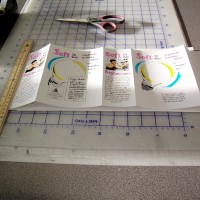
-
SoftBoy prototype
Disseminate
The project is distributed in two ways – in stores and online.
In stores
For the most part we have no idea who made the products we consume, with what, or how it’s done. It’s as if the product appeared magically on the shelves. This AAA project reminds people that the products we consume are made by real people and attempts to remake the connections.
The packaging is designed to be
- easy to download and print on a home computer
- non-damaging to the original product
- quick and easy to attach to the product
These qualities lower the barriers for first-time shopdroppers to attach the PeopleProducts123 packaging to products in a store anywhere in the US and minimize the chances they will be confronted or the consequences if they are.
-
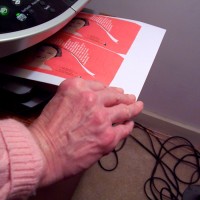
-
color or black & white versions
-
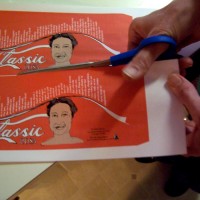
-
cut out the designs and take to the store
-
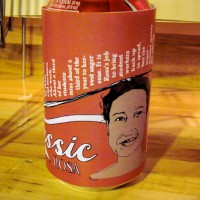
-
sleeves fit easily over products
Online
PeopleProducts123.com has downloadable pdfs so that anyone can print out the packaging at home and place it in their local stores wherever they live. Participants are encouraged to upload their images to flickr (tagged peopleproducts123) to have them included on the site. Some photos of shopdropped packaging have already been posted.
Teach
Amanda Eicher and Steve Lambert led workshops on PeopleProducts123 and the concept of shopdropping in several states including California, New York, Ohio when the PP123 project was launched in 2007.
Video producer Kelly Loudenberg has created a short video about the project and the AAA’s shopdropping workshop at Eyebeam.
Much more information is available on the PeopleProducts123.com site.
Free Downloads
PeopleProducts123.com
PeopleProducts123 reconnects labor and products through improved packaging featuring images and stories about the workers who make them. This improved packaging is placed in stores using a technique called shopdropping (the opposite of shoplifting) in which items are clandestinely left in retail environments.
Research
The Anti-Advertising Agency’s Amanda Eicher traveled to Colima, El Salvador meeting people who make products we consume throughout the world. People like Rosa, a teacher whose student numbers drop during harvest times because the children are working in the fields. Yaneth, a student in town, and people who work for (or subcontract to) companies including Coca-Cola and Dell. When in the Unites States, Amanda worked on reaching out to other photographer/researchers who document laborers both in the US and abroad.
Create
Our idea was to have the image of the person who worked on the product appear on the product itself. The next step was crafting new packaging for the products the laborers from our research work on.
One of the difficulties was establishing direct connections between the labor and the products. The production system is often contracted out and so sophisticated that the employees of a facility often have no idea what they are working on.
The drawings and designs for the packaging were done by Amanda Eicher with Steve Lambert assisting with coloring and providing feedback.
Disseminate
The project is distributed in two ways – in stores and online.
In stores
For the most part we have no idea who made the products we consume, with what, or how it’s done. It’s as if the product appeared magically on the shelves. This AAA project reminds people that the products we consume are made by real people and attempts to remake the connections.
The packaging is designed to be
These qualities lower the barriers for first-time shopdroppers to attach the PeopleProducts123 packaging to products in a store anywhere in the US and minimize the chances they will be confronted or the consequences if they are.
Online
PeopleProducts123.com has downloadable pdfs so that anyone can print out the packaging at home and place it in their local stores wherever they live. Participants are encouraged to upload their images to flickr (tagged peopleproducts123) to have them included on the site. Some photos of shopdropped packaging have already been posted.
Teach
Amanda Eicher and Steve Lambert led workshops on PeopleProducts123 and the concept of shopdropping in several states including California, New York, Ohio when the PP123 project was launched in 2007.
Video producer Kelly Loudenberg has created a short video about the project and the AAA’s shopdropping workshop at Eyebeam.
Much more information is available on the PeopleProducts123.com site.
Free Downloads